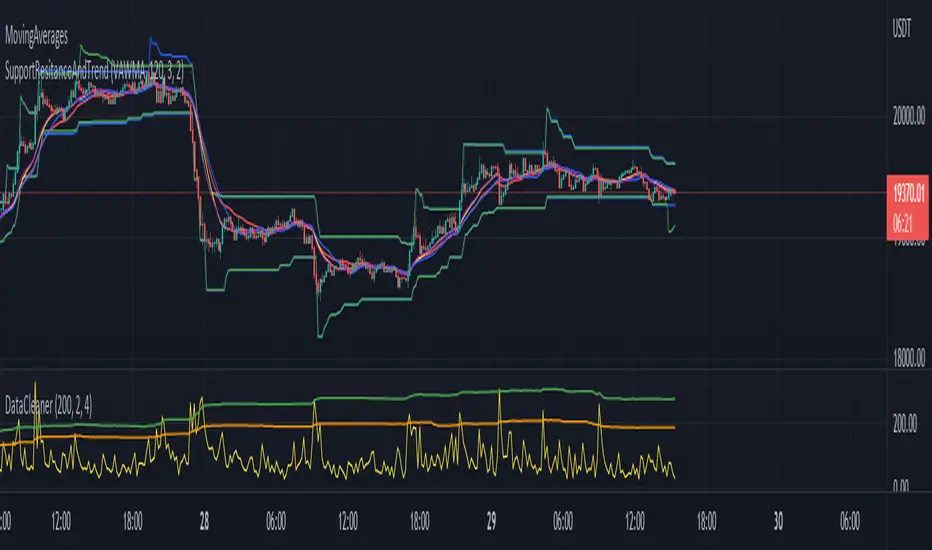PINE LIBRARY
MovingAverages

Library "MovingAverages"
vawma(len, src, volumeDefault)
VAWMA = VWMA and WMA combined. Simply put, this attempts to determine the average price per share over time weighted heavier for recent values. Uses a triangular algorithm to taper off values in the past (same as WMA does).
Parameters:
len: The number of bars to measure with.
src: The series to measure from. Default is 'hlc3'.
volumeDefault: The default value to use when a chart has no (N/A) volume.
Returns: The volume adjusted triangular weighted moving average of the series.
cma(n, D, C, compound)
Coefficient Moving Avereage (CMA) is a variation of a moving average that can simulate SMA or WMA with the advantage of previous data.
Parameters:
n: The number of bars to measure with.
D: The series to measure from. Default is 'close'.
C: The coefficient to use when averaging. 0 behaves like SMA, 1 behaves like WMA.
compound: When true (default is false) will use a compounding method for weighting the average.
ema(len, src)
Same as ta.ema(src,len) but properly ignores NA values.
Parameters:
len: The number of samples to derive the average from.
src: The series to measure from. Default is 'close'.
wma(len, src, startingWeight)
Same as ta.wma(src,len) but properly ignores NA values.
Parameters:
len: The number of samples to derive the average from.
src: The series to measure from. Default is 'close'.
startingWeight: The weight to begin with when calculating the average. Higher numbers will decrease the bias.
vwma(len, src, volumeDefault)
Same as ta.vwma(src,len) but properly ignores NA values.
Parameters:
len: The number of bars to measure with.
src: The series to measure from. Default is 'hlc3'.
volumeDefault: The default value to use when a chart has no (N/A) volume.
get(type, len, src)
Generates a moving average based upon a 'type'.
Parameters:
type: The type of moving average to generate. Values allowed are: SMA, EMA, WMA, VWMA and VAWMA.
len: The number of bars to measure with.
src: The series to measure from. Default is 'close'.
Returns: The moving average series requested.
vawma(len, src, volumeDefault)
VAWMA = VWMA and WMA combined. Simply put, this attempts to determine the average price per share over time weighted heavier for recent values. Uses a triangular algorithm to taper off values in the past (same as WMA does).
Parameters:
len: The number of bars to measure with.
src: The series to measure from. Default is 'hlc3'.
volumeDefault: The default value to use when a chart has no (N/A) volume.
Returns: The volume adjusted triangular weighted moving average of the series.
cma(n, D, C, compound)
Coefficient Moving Avereage (CMA) is a variation of a moving average that can simulate SMA or WMA with the advantage of previous data.
Parameters:
n: The number of bars to measure with.
D: The series to measure from. Default is 'close'.
C: The coefficient to use when averaging. 0 behaves like SMA, 1 behaves like WMA.
compound: When true (default is false) will use a compounding method for weighting the average.
ema(len, src)
Same as ta.ema(src,len) but properly ignores NA values.
Parameters:
len: The number of samples to derive the average from.
src: The series to measure from. Default is 'close'.
wma(len, src, startingWeight)
Same as ta.wma(src,len) but properly ignores NA values.
Parameters:
len: The number of samples to derive the average from.
src: The series to measure from. Default is 'close'.
startingWeight: The weight to begin with when calculating the average. Higher numbers will decrease the bias.
vwma(len, src, volumeDefault)
Same as ta.vwma(src,len) but properly ignores NA values.
Parameters:
len: The number of bars to measure with.
src: The series to measure from. Default is 'hlc3'.
volumeDefault: The default value to use when a chart has no (N/A) volume.
get(type, len, src)
Generates a moving average based upon a 'type'.
Parameters:
type: The type of moving average to generate. Values allowed are: SMA, EMA, WMA, VWMA and VAWMA.
len: The number of bars to measure with.
src: The series to measure from. Default is 'close'.
Returns: The moving average series requested.
Pine library
In true TradingView spirit, the author has published this Pine code as an open-source library so that other Pine programmers from our community can reuse it. Cheers to the author! You may use this library privately or in other open-source publications, but reuse of this code in publications is governed by House Rules.
Disclaimer
The information and publications are not meant to be, and do not constitute, financial, investment, trading, or other types of advice or recommendations supplied or endorsed by TradingView. Read more in the Terms of Use.
Pine library
In true TradingView spirit, the author has published this Pine code as an open-source library so that other Pine programmers from our community can reuse it. Cheers to the author! You may use this library privately or in other open-source publications, but reuse of this code in publications is governed by House Rules.
Disclaimer
The information and publications are not meant to be, and do not constitute, financial, investment, trading, or other types of advice or recommendations supplied or endorsed by TradingView. Read more in the Terms of Use.